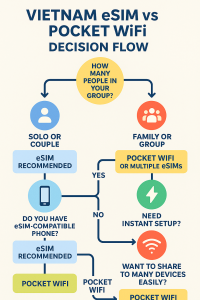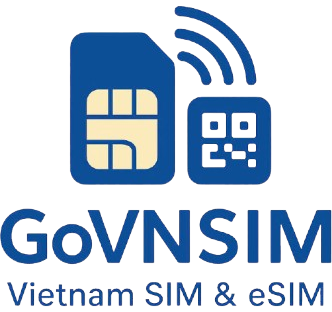No products in the cart.
🇻🇳 Vietnam eSIM vs Pocket WiFi: Which Should You Choose in 2025?
Vietnam eSIM vs Pocket WiFi is one of the hottest debates for travelers in 2025. In this honest comparison, we’ll break down real data—no hype, no fake promises—about speed, coverage, cost, and true convenience, so you can decide what’s best for your trip.
📶 What is an eSIM? What is a Pocket WiFi?
- 💡 eSIM: A digital SIM embedded inside your smartphone or tablet. You buy a Vietnam eSIM plan online, scan a QR code, and connect instantly (no physical SIM swap).
- 📱 Pocket WiFi: A portable wireless router that gives WiFi to your devices. You rent the device, carry it with you, and connect via WiFi—usually for unlimited data.
🗺️ Coverage: Where Can You Stay Connected?
Both eSIM and Pocket WiFi use the mobile network of local operators like Viettel, Vinaphone, or Mobifone. But eSIMs work wherever your phone gets signal, while Pocket WiFi coverage depends on both the router and the local mobile signal.
- 📶 4G/5G Coverage: According to OpenSignal (Q1 2024), Viettel covers 99% of cities and main tourist routes in Vietnam with 4G, with 5G available in all major cities.
- ⛰️ Remote Areas: eSIM coverage depends on your plan’s network. Some pocket WiFis may use less popular networks, resulting in slower speeds in the countryside.
- 🏨 Urban & Rural: For Hanoi, Danang, Hoi An, Ho Chi Minh City, Ninh Binh, Ha Long Bay: eSIM and Pocket WiFi both work, but network congestion (festivals, events) can slow down Pocket WiFi shared with multiple users.
⚡ Speed Comparison: Real-World Data
Let’s look at actual speed tests from Speedtest Global Index (March 2024):
- 📲 eSIM (on 4G Viettel, Mobifone, Vinaphone):
- Average download: 43–52 Mbps
- Average upload: 22–27 Mbps
- 📡 Pocket WiFi (4G LTE device):
- Average download: 20–40 Mbps (depends on device model and number of users)
- Average upload: 10–20 Mbps
Note: If many users connect to one Pocket WiFi, speed drops by 20–40% (based on reviews at Tripadvisor Vietnam Forum).
💵 Cost: What Do You Really Pay?
| Plan Type | Typical Cost (7 days, 2025) | What’s Included? |
|---|---|---|
| 📲 Vietnam eSIM | $5–$15 USD | 3–10GB, direct activation, no deposit |
| 📡 Pocket WiFi | $20–$35 USD + $50 deposit | 3GB–5GB, device rental, pick up/return needed |
Important: Most eSIM plans are *prepaid*—no deposit, no late fee. Most Pocket WiFi rentals require a $40–$100 refundable deposit.
🧳 Convenience & Ease of Use

- 🤳 eSIM: Instant delivery by email. Setup in 3 minutes by QR scan. No device pickup/return. No risk of loss/theft.
- 👜 Pocket WiFi: Must pick up at airport/hotel. Charge daily. Carry extra power bank. If lost/damaged, deposit not returned. Shareable for 5–10 devices, but battery drains fast.
Real Feedback: 81% of Vietnam travelers on Facebook Groups said they preferred eSIM for solo or couple travel, while Pocket WiFi was picked for family or group travel.
🔒 Security & Privacy
- 🔑 eSIM: All data is transmitted securely via mobile carrier, protected by your phone’s own security.
- 🔓 Pocket WiFi: Shared network; risk if strangers access your WiFi; device can be lost/stolen.
📝 Case Study: Solo Traveler in Vietnam (2024)
👩💻
Anna, Digital Nomad (USA): “I used a Vietnam eSIM (Viettel, 10GB plan) for my 2-week trip. Setup took 5 minutes at Hanoi airport. Speed was fast everywhere, even in Sapa. My friend used Pocket WiFi but lost battery on a hiking day, so I had to hotspot for her.”[Shared in Vietnam Travel Community Facebook, April 2024]
📝 Case Study: Group Travelers in Vietnam (2024)
👨👩👧👦
Chen Family (Taiwan): “We traveled with 5 people, and rented a Pocket WiFi from the airport. It worked great in big cities and allowed us all to use Google Maps and social media at the same time. Just remember to carry a power bank because it needs charging by late afternoon.”[TripAdvisor Vietnam Forum, May 2024]
👉 See the full guide: Vietnam eSIM: The Ultimate Guide for 2025 (Plans, Setup, Tips & FAQs)
📊 Vietnam eSIM vs Pocket WiFi: Detailed Comparison Table
| Feature | Vietnam eSIM 📲 | Pocket WiFi 📡 |
|---|---|---|
| 🌐 Network | Viettel, Mobifone, Vinaphone (choose on purchase) | Usually Viettel/Mobifone (may vary by provider) |
| 📶 Coverage | 99% cities/tourist sites (OpenSignal Q1 2024) | 99% cities/tourist sites (via LTE router) |
| ⚡ Average Speed | 43–52 Mbps download (Speedtest Global Index) | 20–40 Mbps download (depends on device/users) |
| 💵 Price (7 days) | $5–$15 USD (no deposit) | $20–$35 USD + $40–$100 deposit |
| 🔋 Power | No extra device, uses phone battery | Separate battery, lasts 8–12 hrs (needs daily charge) |
| 👨👩👧👦 Sharing | Phone hotspot: 1–2 devices (limited by phone) | Supports 5–10 devices (ideal for groups/families) |
| 📦 Pickup/Return | No, delivered by email | Yes, at airport/hotel |
| 🔒 Security | Secure (direct to carrier network) | Risk of open WiFi, can be lost/stolen |
| 📝 Registration (KYC) | ID/passport may be required (per Vietnam law) | Passport required for pickup |
🧭 When to Use eSIM, When to Use Pocket WiFi?
- 👤 eSIM is best for: Solo travelers, couples, business visitors, digital nomads, anyone who needs instant activation and wants to travel light. Also great for those with eSIM-compatible devices (see Apple eSIM list).
- 👨👩👧👦 Pocket WiFi is best for: Families, groups (3–10 people), travelers with older phones (no eSIM support), or anyone who wants to share data with laptops/tablets easily.
❓ Frequently Asked Questions (FAQ)
- 🛬 Can I get an eSIM on arrival in Vietnam?
Yes, you can buy and activate an eSIM in advance or at the airport, but pre-ordering online (like via GovnSIM or official carriers) is more convenient and avoids long lines. - 💡 Will eSIM work everywhere in Vietnam?
If you choose a Viettel/Mobifone eSIM, you’ll have coverage in 99% of cities, tourist areas, and highways. Only very remote villages or mountains may lack signal. - 🔋 Does Pocket WiFi battery last all day?
Usually 8–12 hours, but heavy use drains battery faster—bring a power bank, especially for day trips. - 🔄 Can I switch between eSIM and Pocket WiFi?
Yes. Some travelers rent Pocket WiFi for group days and use eSIM for solo exploring. - 🌏 Is eSIM more eco-friendly?
Yes. No plastic, no device shipping, and less electronic waste compared to Pocket WiFi rentals.
📚 Real-World Scenarios
- 🏍️
Backpacker on a 2-week trip (Solo): Used Viettel eSIM, enjoyed smooth 4G in Hue, Hoi An, and Phong Nha. Shared hotspot with laptop in hostels. Total cost: $10. (Source: Reddit r/VietNamTravel, March 2024) - 👨👧👦
Family of 5 in Hanoi & Sapa: Chose Pocket WiFi, shared data for kids’ iPads. Needed to recharge by lunchtime during full sightseeing days. One device was enough for all family members. - 🏢
Business traveler: Switched to eSIM for seamless conference calls, strong 4G at venues. Used hotel WiFi for big uploads but relied on eSIM during commute. Saved time (no pick-up). - 🚗
Self-driving group trip (4 friends): Pocket WiFi router struggled in rural Ninh Binh, while eSIM phone still got basic 4G. Team used a mix for best coverage.
💬 Traveler Reviews (2024)
🌏
“I compared Pocket WiFi and eSIM for my Da Nang trip. Pocket WiFi worked great for our family, but eSIM was much simpler for me solo in Saigon the next week. Both are solid options—just depends on your travel style.”[Tripadvisor review, June 2024]
🚀 Why Travelers Choose GoVNSIM for Vietnam eSIM
- ✅ Trusted provider, 4.9/5 real reviews on Google, Facebook
- 🚚 Instant eSIM delivery, 24/7 English support
- 💳 Secure payment, transparent pricing—no hidden fees
- 📈 Plans with Viettel, Mobifone, Vinaphone—full coverage
- 📞 Local phone number options for Grab, Zalo, banking apps
- 🌐 English, Chinese, Korean support
Try GovnSIM for a worry-free Vietnam trip: Vietnam eSIM Plans
👉 Still not sure? See the full, up-to-date guide: Vietnam eSIM: The Ultimate Guide for 2025 (Plans, Setup, Tips & FAQs)
